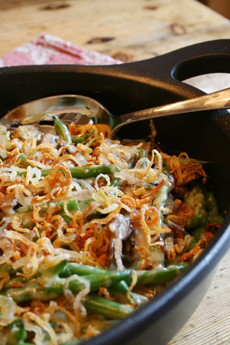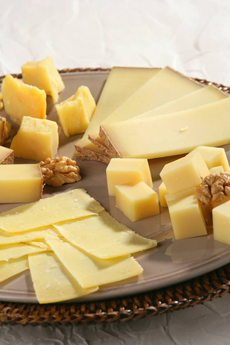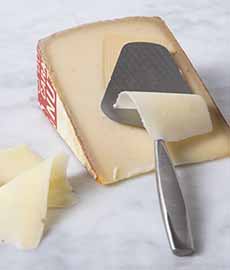Gourmet Green Bean Casserole Recipe With Comte Cheese
 [1] A green bean casserole smothered with delicious Comté cheese (photo © Comté USA).
|
In our mother’s day, green bean casserole was a popular family dish. We can’t remember the last decade we saw one, either at home or on a restaurant menu. So St. Patrick’s Day, coming up on March 17th, seems like the time to try a good recipe and put more green on the table. This recipe was shared with us by Comté USA, the American bureau for France’s popular Comté cheese. Also called Gruyère de Comté, it has a much milder flavor than the Swiss Gruyère, aged for only three months compared to 8 months for Swiss Gruyère. How popular is it? Comté has the highest production of all French AOC cheeses: around 40,000 tonnes* annually. Dating back to the 12th century, Comté is made from unpasteurized cow’s milk in the Franche-Comté region of eastern France. Here’s some fun cheese trivia: Comté is made only during the summer months, in huge wheels. In the fall, milk from the same cows is used to make Vacherin Mont d’Or, a small, creamy cheese that couldn’t be more different. You’ll note that the recipe below is for a green bean gratin, not a casserole. What’s the difference? A gratin is any dish that is topped with cheese or breadcrumbs mixed with butter, then heated in the oven or under the broiler until brown and crispy. In French, the phrase au gratin means “by grating” in French, or “with a crust,” from the verb gratter, to scrape, scratch, or grate. > There’s more about Comte cheese below, including the history of the 1,000+-year-old-cheese. > December 3rd is National Green Bean Casserole Day. > January 6th is National Bean Day, celebrating all types of beans. > The different types of beans and grains: a photo glossary. *In American English, a ton is a unit of measurement equaling 2,000 pounds. In Europe and elsewhere, a tonne equals 2,240 pounds (1000 kg). Don’t assume it’s the same measurement with a different spelling! |
|
|
RECIPE: GREEN BEAN & MUSHROOM GRATIN WITH COMTÉ & FRIED SHALLOTS This is a sophisticated version of a classic green bean casserole. No condensed cream of mushroom soup, no canned French-fried onions! Ingredients †Cremini/crimini mushrooms are baby portabello/portobello mushrooms, often marketed as Baby Bellas. Check out the different types of mushrooms in our Mushroom Glossary. |
||
|
Preparation 1. LINE a large plate with paper towels. In a small saucepan, heat the oil over medium-high heat until it begins to shimmer and lightly smoke. Add the shallots and cook, stirring often, until light golden brown, about 7-9 minutes. Using a slotted spoon, transfer the shallots to the paper towel-lined plate. Sprinkle with ¼ teaspoon salt. 2. PREHEAT the oven to 400°F. Butter a 2-quart casserole dish. 3. BRING a large pot of salted water to a boil. Add the green beans and cook until crisp-tender, 4-5 minutes. While the beans cook, fill a large bowl with ice water. Drain the beans and immediately plunge them into the ice water to stop cooking. Transfer to a clean kitchen towel to dry. 4. MELT the butter in a large skillet over medium-high heat. Add the mushrooms and toss. Cook, stirring occasionally, until golden brown, about 5 minutes. Add 1 teaspoon salt, ½ teaspoon pepper and the minced garlic; cook 1 minute. Sprinkle in the flour and cook, stirring, 30 seconds. Whisk in the broth and milk and bring to a simmer. Cook 5-6 minutes, or until thickened. |
 Comté cheese (photo © Comte USA). |
|
|
5. TURN off the heat and add half of the shredded Comté, along with ½ teaspoon salt and ¼ teaspoon pepper. Stir until the cheese is melted. Add the green beans and stir to coat. 6. TRANSFER the mixture to the prepared baking dish. Sprinkle the remaining Comté over the top. Bake 10 minutes. Before serving, sprinkle the fried shallots over the gratin. Serve warm. Like Beaufort, Emmental (Emmentaler), Gruyère, Raclette, and others, Comté is a mountain cheese—a cooked, pressed curd cheese. The curds are cut very small when producing a mountain cheese to expel more whey (water), making a more firm paste. Mountain cheeses are typically made in large wheels, 60 pounds or more. Comté has an ivory-colored paste with scattered of eyes (holes) the size of hazelnuts. It is known for its complex, nutty, buttery, and caramelized flavor. There can also be a slight smoky flavor, produced when the curd is cooked. The cheese often exhibits flavors of fruits, nuts, hay, and a hint of sweetness. The eyes are the result of proper affinage (aging). Unlike Emmental, for example, which has larger eyes, the eyes of Comté should be the size of a pea up to a hazlenut or small cherry. The texture that can range from firm and crumbly in younger versions to smoother and more supple in older ones (more about that below). Made for 1,000 years, since the time of Charlemagne, Comté originated in the Jura region of eastern France, near the border with Switzerland. The cheese gets its name from the Franche-Comté region, where it has been produced for centuries. The production of Comté can be traced back to the Middle Ages when local monasteries and farmers in the region began making the cheese as a way to preserve the excess milk produced by their cows (which is how most cheese-making began). In 1958, Comté became one of the first cheeses in France to receive the A.O.C. (Appellation d’Origine Contrôlée) designation, which ensures that the cheese is produced following specific criteria and in the designated geographical area. Subsequent to the establishment of the European Union in 1993, the A.O.C. designation was replaced by the P.D.O. (Protected Designation of Origin) designation, further emphasizing the connection between the cheese and its specific region of origin. Strict A.O.C. rules that ensure that each wheel of Comté is just as perfect as the last. The cheese is produced in large 70- to 80-pound wheels from unpasteurized (raw) cows’ milk on more than 3,000 family farms in the French Alps. The production of Comté is limited to the Jura region, and only milk from Montbéliarde or French Simmental cows, which graze on rich mountain pastures, is used in its production. The dairy farmers practice non-intensive agriculture, which focuses on quality rather than the highest possible yields. The production methods have been passed down through generations. The use of raw milk contributes to the unique flavor and characteristics of the cheese. Today Comté is made at 190 cheese dairies, known as the fruitières, in the Jura plateau. Cheesemakers need about 530 liters of milk—the daily production of 30 cows—to make one 80-pound (35 kilos) wheel of Comté. By law, production must start within 24 hours of milking, so the cheese is made daily. Morning and evening milks from Montbeliarde and Tachete de L’est cows are mixed [source]. Comté cheese can be matured for varying lengths of time, and the duration of maturation significantly influences the flavor, texture, and characteristics of the cheese. The maturation process for Comté typically ranges from a few months to several years. The wheels age on spruce boards, where they develop a tight-knit texture and satiny body. The cheese is regularly cleaned and rubbed with salted water. The different age classifications of Comté are: The choice of maturation depends on personal preference; each age category offers a different tasting experience. |
||
